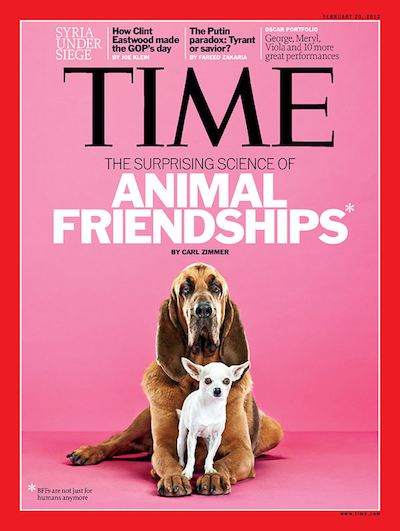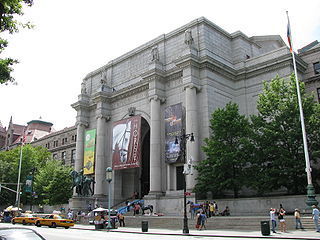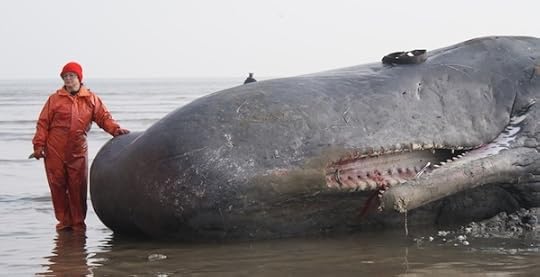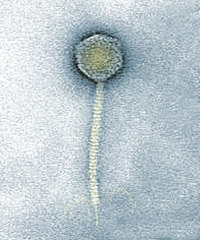Carl Zimmer's Blog, page 50
February 9, 2012
Animal Friendships: My cover story for Time magazine

I've got a story on the cover of the latest issue of Time. It's about the evolutionary origins of friendship. For a number of scientists, friendship–in a deep sense of the word–is not limited to our own species. The fact that friendship may be a widespread biological phenomenon could help us better understand why it has such a positive effect on our own health.
If you're interested in the scientific literature, the best way in–and the way I first started to get familiar with it–is this review in the latest issue of Annual Review of Psychology by Dorothy Cheney and Robert Seyfarth, two of the world's leading primatologists.
One thing that I delve into in the story is the question of just how widespread animal friendship really is. We don't know, in large part because scientists haven't done that many long-term field studies on wild animals. When scientists do watch dolphins or baboons for decades, they can see some bonds between unrelated individuals that last for long stretches. (Yet another value that comes from slow-cooked science.) On the other hand, what may look like friendship may just be anthropomorphic ...

The Future of E-books–podcast of my interview on Wisconsin Public Radio
 WPR has posted the podcast of my talk last week on the Ben Merens show on their site–including a lot of interesting comments from callers. (Direct link to MP3)
WPR has posted the podcast of my talk last week on the Ben Merens show on their site–including a lot of interesting comments from callers. (Direct link to MP3)
[Image: Jonathan Franzen's Freedom on an Iphone. Gasp! Prepare for the Apocalypse! Photo by badosa on Flickr/Creative Commons]
February 8, 2012
Thursday, February 16: Science and social media panel in New York
 Next week is Social Media Week, during which time the American Museum of Natural History is hosting an exploration of science and social media. It will take place on Thursday, 2/16, at 6 pm, and after the official panel discussion there will be a beer and wine reception in the Museum's Hall of Minerals and Gems.
Next week is Social Media Week, during which time the American Museum of Natural History is hosting an exploration of science and social media. It will take place on Thursday, 2/16, at 6 pm, and after the official panel discussion there will be a beer and wine reception in the Museum's Hall of Minerals and Gems.
The panelists for the evening include–
Ben Lillie, the physicist turned spoken-word impresario who has founded the delightful Story Collider
Matt Danzico, a BBC journalist who conducted a 365-day blog experiment called "The Time Hack" looking at how we perceive time
Ruth Cohen, Director of the Center for Lifelong Learning at the American Museum of Natural History, who will talk about how the museum uses apps to help kids learn about urban biodiversity
–and me. I'll talk about how social media (primarily the Loom) turned me into a curator of science tattoos and then an author of a decidedly unusual coffee table book.
The discussion will be moderated by Jennifer Kingson, an editor in the Science Department at The New York Times.
The event is free, but you need to register on the event page.

February 6, 2012
A Scientific Jonah: My profile of Joy Reidenberg in tomorrow's New York Times
 For anyone in the US who likes to know what it's like inside a giraffe (hands up, people), it was frustrating to discover the show Inside Nature's Giants airing on British TV. The best we could manage were snippets on YouTube. Now the show is here in the States. The other day I spent some time with one of the main scientists of the show, Joy Reidenberg, an anatomist at Mount Sinai School of Medicine. I've written a profile of her, both as a researcher who's discovering fascinating new things about whales, and as that most improbable thing: a celebrity anatomist. Check it out.
For anyone in the US who likes to know what it's like inside a giraffe (hands up, people), it was frustrating to discover the show Inside Nature's Giants airing on British TV. The best we could manage were snippets on YouTube. Now the show is here in the States. The other day I spent some time with one of the main scientists of the show, Joy Reidenberg, an anatomist at Mount Sinai School of Medicine. I've written a profile of her, both as a researcher who's discovering fascinating new things about whales, and as that most improbable thing: a celebrity anatomist. Check it out.
Be sure to take a look at the extras on the page, such as the podcast, video, and graphic instructions for how to dissect a 50-ton whale.
[Photo courtesy of Joy Reidenberg]

February 3, 2012
Ebooks on the radio: 6 pm ET tonight
I'll be talking on Wisconsin Public Radio with host Ben Merens about ebooks and the future of publishing. I'll be on for the hour from 5 pm to 6 pm CT (6-7 ET) You can listen live here.

February 2, 2012
Flu Fighters
Michael Osterholm, his face a pink-cheeked scowl, looked out across the table, beyond the packed room at the New York Academy of Sciences, and out through the windows. The New York Academy of Sciences is housed on the fortieth floor of 7 World Trade Center, and their endless bank of windows affords a staggering view of Manhattan, Brooklyn, and New Jersey. One reason that its view is so magnificent is that there's a huge gap in the skyline–and a huge gouge in the ground–where the Twin Towers once stood.
Osterholm had come here from Minnesota, where he runs a research center for infections diseases and terrorism, to talk Thursday night about the threat of a new kind of flu sitting in labs in the Netherlands and Wisconsin. In nature, it's a flu that spreads easily between birds but doesn't travel well from human to human. The Dutch and Wisconsin scientists had found ways to get this bird flu, known as H5N1, to move between ferrets. For Osterholm, ferrets were uncomfortably close to humans on the evolutionary tree. And so he, along with other members of an advisory board, issued a recommendation in December that key information in the papers about ...
January 31, 2012
The Crux: My response to Jonathan Franzen's e-book rant

The novelist Jonathan Franzen delivered quite a rant about e-books the other day. He's deeply wrong, as I explain at the Crux by going shopping for a copy of The Great Gatsby. Check it out.
Life turned upside down
 Thousands of papers get published every week, but every now and then a truly strange one pops up. On December 23, a new journal called Life published a paper by Case Western Reserve University biochemist Eric Andrulis called "Theory of the Origin, Evolution, and Nature of Life."
Thousands of papers get published every week, but every now and then a truly strange one pops up. On December 23, a new journal called Life published a paper by Case Western Reserve University biochemist Eric Andrulis called "Theory of the Origin, Evolution, and Nature of Life."
At Ars Technica, John Timmer unpacks this 105-page paper and delves into the weirdness, in a post called "How the craziest f#@!ing paper got published and promoted."
The basic idea is that everything, from subatomic particles to living systems, is based on helical systems the author calls "gyres," which transform matter, energy, and information. These transformations then determine the properties of various natural systems, living and otherwise. What are these gyres? It's really hard to say; even Andrulis admits that they're just "a straightforward and non-mathematical core model" (although he seems to think that's a good thing). Just about everything can be derived from this core model; the author cites "major phenomena including, but not limited to, quantum gravity, phase transitions of water, why living systems are predominantly CHNOPS (carbon, hydrogen, nitrogen, oxygen, phosphorus, and sulfur), homochirality of sugars and amino acids, homeoviscous adaptation, triplet ...
January 26, 2012
Viruses learn new tricks, in real time: my story in tomorrow's New York Times
 Charles Darwin recognized that natural selection can make eyes sharper, muscles stronger, and fur thicker. But evolution does more than just improve what's already there. It also gives rise to entirely new things—like eyes and muscles and fur. To study how new things evolve, biologists usually have to rely on ancient clues left behind for hundreds of millions of years. But in a study published today, scientists at Michigan State University show that it's possible to watch something new evolve in front of their eyes, in just a couple weeks.
Charles Darwin recognized that natural selection can make eyes sharper, muscles stronger, and fur thicker. But evolution does more than just improve what's already there. It also gives rise to entirely new things—like eyes and muscles and fur. To study how new things evolve, biologists usually have to rely on ancient clues left behind for hundreds of millions of years. But in a study published today, scientists at Michigan State University show that it's possible to watch something new evolve in front of their eyes, in just a couple weeks.
The scientists were studying a virus, which evolved a new way of invading cells. As a result, their research not only sheds light on a fundamental question about evolution. It also suggests that it may worryingly easy for viruses such as influenza to turn into new epidemics. Check it out.
[Image of lambda virus: AJC1 on Flickr via Creative Commons]

January 24, 2012
Archaeopteryx: The Embargoed Tattoo
 A fair number of scientists like to get a tattoo to celebrate their research. Ryan Carney, a biologist at Brown University has taken the practice one step further. He's gotten a tattoo that shows the key finding of a paper he and his colleagues have just published today. They studied a fossil feather from Archaeopteryx, the iconic bird (or almost-bird). They conclude it looked just like this tattoo.
A fair number of scientists like to get a tattoo to celebrate their research. Ryan Carney, a biologist at Brown University has taken the practice one step further. He's gotten a tattoo that shows the key finding of a paper he and his colleagues have just published today. They studied a fossil feather from Archaeopteryx, the iconic bird (or almost-bird). They conclude it looked just like this tattoo.
Carney collaborated on the research with a team of scientists who have developed a method to reconstruct colors from fossils. One source of colors in animals is a cellular structure called a melanosome. Depending on the size, shape, and spacing of melanosomes, they can produce a range of hues. It turns out that melanosomes are incredibly rugged, sometimes enduring for millions of years.
As I wrote in the New York Times in 2009, the scientists first found melanosomes in the ink sac of a fossil squid and then went on to look at a 47-million-year-old bird feather. Then they went on to look at the feathers and feather-like structures of dinosaurs, reconstructing some of the colors of their plumage. The color pattern, ...
















